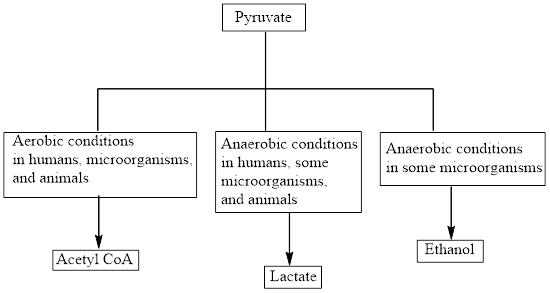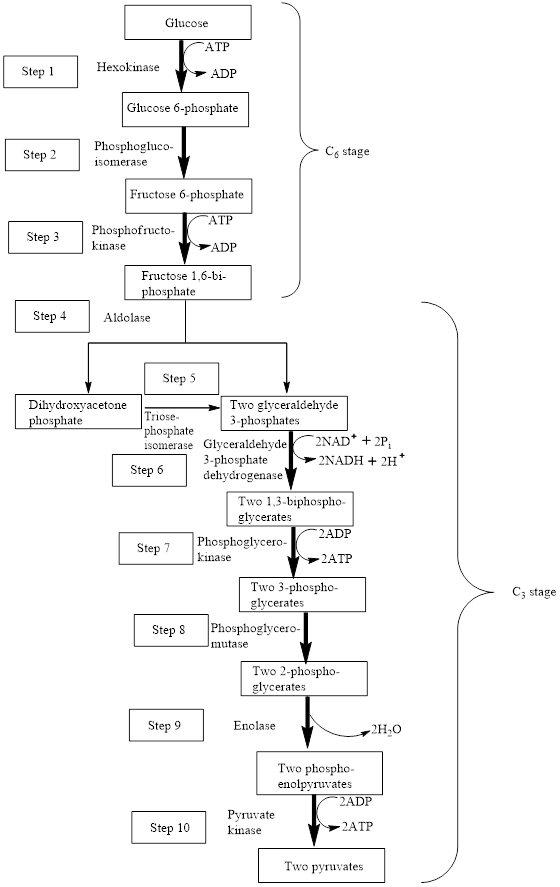
Concept explainers
(a)
Interpretation: To indicate whether
Concept introduction: In the glycolysis
Pyruvate is the end product in the glycolysis. The production of the fate of pyruvate varies with the nature of the organism and the cellular conditions. The three common fates of pyruvate are as follows:

(a)
Answer to Problem 24.47EP
Carbon dioxide
Explanation of Solution
Reason for correct option:
Under aerobic conditions, pyruvate is converted to

The overall reaction equation for the conversion of pyruvate to
The process of ethanol fermentation takes place in two steps. In step 1, the pyruvate molecule is converted to acetaldehyde by pyruvate decarboxylase enzymes. Carbon dioxide molecule is produced in this step. The chemical reaction is as follows:

In step 2, acetaldehyde is reduced to ethanol by alcohol dehydrogenase enzymes. The chemical reaction is as follows:

The overall ethanol fermentation equation is as follows:
Therefore,
Reason for incorrect option:
The net overall equation for the glycolysis process is as follows:
The overall reaction equation for lactate fermentation is as follows:
(b)
Interpretation: To indicate whether
Concept introduction: In the glycolysis metabolic pathway, a glucose molecule breaks down into two pyruvate molecules. Two ATP molecules and NADH reduced coenzymes are produced in the glycolysis pathway.
Pyruvate is the end product in the glycolysis. The production of the fate of pyruvate varies with the nature of the organism and the cellular conditions. The three common fates of pyruvate are as follows:

(b)
Answer to Problem 24.47EP
Pyruvate is oxidized to
Explanation of Solution
Reason for correct option:
Under aerobic conditions, pyruvate is converted to
Reason for incorrect option:
The net overall equation for the glycolysis process is as follows:
The overall ethanol fermentation equation is as follows:
The overall reaction equation for lactate fermentation is as follows:
(c)
Interpretation: To indicate whether ATP is associated with (1) glycolysis, (2) pyruvate oxidation, (3) lactate fermentation, or (4) ethanol fermentation.
Concept introduction: In the glycolysis metabolic pathway, a glucose molecule breaks down into two pyruvate molecules. Two ATP molecules and NADH reduced coenzymes are produced in the glycolysis pathway.
Pyruvate is the end product in the glycolysis. The production of the fate of pyruvate varies with the nature of the organism and the cellular conditions. The three common fates of pyruvate are as follows:

(c)
Answer to Problem 24.47EP
A net gain of two ATP molecules occurs when one glucose molecule is converted to two pyruvate molecules through the glycolysis pathway. Therefore, ATP is associated with (1) glycolysis.
Explanation of Solution
Reason for correct choice:
The block diagram to represent an overview of glycolysis is as follows:

The net overall equation for the glycolysis process is as follows:
In step 1 and step 3, one ATP molecule is consumed in each step. In step 7 and step 10, two ATP molecules are produced in each step. Hence, in the glycolysis pathway, two ATP molecules are consumed and four ATP molecules are produced. Therefore, a net gain of two molecules of ATP occurs in the glycolysis pathway.
Reason for incorrect choice:
The overall reaction equation for the oxidation of pyruvate is as follows:
The overall ethanol fermentation equation is as follows:
The overall reaction equation for lactate fermentation is as follows:
ATP is neither consumed nor formed in the pyruvate oxidation, ethanol fermentation, and lactate fermentation. Therefore, ATP is not associated with pyruvate oxidation, ethanol fermentation, and lactate fermentation.
(d)
Interpretation: To indicate whether NADH is associated with (1) glycolysis, (2) pyruvate oxidation, (3) lactate fermentation, or (4) ethanol fermentation.
Concept introduction: In the glycolysis metabolic pathway, a glucose molecule breaks down into two pyruvate molecules. Two ATP molecules and NADH reduced coenzymes are produced in the glycolysis pathway.
Pyruvate is the end product in the glycolysis. The production of the fate of pyruvate varies with the nature of the organism and the cellular conditions. The three common fates of pyruvate are as follows:

(d)
Answer to Problem 24.47EP
In the glycolysis process and oxidation of pyruvate, NADH is formed as a product while it is encountered as a reactant in lactate fermentation and ethanol fermentation. Therefore, NADH is associated with (1) glycolysis, (2) pyruvate oxidation, (3) lactate fermentation, and (4) ethanol fermentation.
Explanation of Solution
The net overall equation for the glycolysis process is as follows:
The overall reaction equation for the conversion of pyruvate to
The overall ethanol fermentation equation is as follows:
In the absence of oxygen, pyruvate is converted to lactate by lactate dehydrogenase enzymes in the human body. The overall reaction equation for the conversion of pyruvate to lactate is as follows:
NADH is produced in the glycolysis process and pyruvate oxidation while it is consumed in ethanol fermentation and lactate fermentation. Therefore, NADH is associated with all four processes.
Want to see more full solutions like this?
Chapter 24 Solutions
General, Organic, and Biological Chemistry
- In this question, the product of the aldol condensation is shown. What would be the reactants for this product? Please provide a detailed explanation, as well as a drawing showing how the reactants will react to produce the product.arrow_forward7. Propene undergoes a hydration reaction with water in the presence of an acid. a. There are two possible products for this reaction, both with the formula C,H,O. Show their structural formulas and names. (A1, B2) SCH4UR Name: (answer for part a. here!) VER 3 2021-2022 b. Which of the two products do you predict will form. Explain your choice using details from your learning. (B3)arrow_forwardWhat are the major products of the following organic reaction? Please include a detailed explanation as well as a drawing as to how the reaction proceeds.arrow_forward
- What are the major products of the following reaction? Please provide a detailed explanation and a drawing to show how the reaction proceeds.arrow_forwardWhat are the major products of the following organic reaction? Please include a detailed explanation as well as a drawing as to how the reaction proceeds.arrow_forwardPredict the organic product that forms in the reaction below: H + гон OH H+ H+ ☑ O Note: You may assume you have an excess of either reactant if the reaction requires more than one of those molecules to form the product. In the drawing area below, draw the skeletal ("line") structure of the missing organic product X. Explanation Check Click and drag to start drawing a structure. S 2025 McGraw Hill LLC. All Rights Reserved. Terms of Use | Privacy Centearrow_forward
- In the analysis of Mg content in a 25 mL sample, a titration volume of 5 mL was obtained using 0.01 M EDTA. Calculate the Mg content in the sample if the Ca content is 20 ppmarrow_forwardPredict the organic products that form in the reaction below: H. H+ + OH H+ Y Note: You may assume you have an excess of either reactant if the reaction requires more than one of those molecules to form the products. In the drawing area below, draw the skeletal ("line") structures of the missing organic products X and Y. You may draw the structures in any arrangement that you like, so long as they aren't touching. Explanation Check Click and drag to start drawing a structure. G X C © 2025 McGraw Hill LLC. All Rights Reserved. Terms of Use | Privacy Center | Access +arrow_forward111 Carbonyl Chem Choosing reagants for a Wittig reaction What would be the best choices for the missing reagents 1 and 3 in this synthesis? 1. PPh3 3 1 2 2. n-BuLi • Draw the missing reagents in the drawing area below. You can draw them in any arrangement you like. Do not draw the missing reagent 2. If you draw 1 correctly, we'll know what it is. • Note: if one of your reagents needs to contain a halogen, use bromine. Explanation Check Click and drag to start drawing a structure. × ©2025 McGraw Hill LLC. All Rights Reserved. Terms of Usearrow_forward
- A student proposes the transformation below in one step of an organic synthesis. There may be one or more reactants missing from the left-hand side, but there are no products missing from the right-hand side. There may also be catalysts, small inorganic reagents, and other important reaction conditions missing from the arrow. • Is the student's transformation possible? If not, check the box under the drawing area. . If the student's transformation is possible, then complete the reaction by adding any missing reactants to the left-hand side, and adding required catalysts, inorganic reagents, or other important reaction conditions above and below the arrow. • You do not need to balance the reaction, but be sure every important organic reactant or product is shown. + T X O O лет-ле HO OH HO OH This transformation can't be done in one step.arrow_forwardDetermine the structures of the missing organic molecules in the following reaction: X+H₂O H* H+ Y OH OH Note: Molecules that share the same letter have the exact same structure. In the drawing area below, draw the skeletal ("line") structures of the missing organic molecules X and Y. You may draw the structures in any arrangement that you like, so long as they aren't touching. Click and drag to start drawing a structure. X Sarrow_forwardPredict the major products of this organic reaction. If there aren't any products, because nothing will happen, check the box under the drawing area instead. No reaction. HO. O :☐ + G Na O.H Click and drag to start drawing a structure. XS xs H₂Oarrow_forward
 Chemistry for Today: General, Organic, and Bioche...ChemistryISBN:9781305960060Author:Spencer L. Seager, Michael R. Slabaugh, Maren S. HansenPublisher:Cengage Learning
Chemistry for Today: General, Organic, and Bioche...ChemistryISBN:9781305960060Author:Spencer L. Seager, Michael R. Slabaugh, Maren S. HansenPublisher:Cengage Learning General, Organic, and Biological ChemistryChemistryISBN:9781285853918Author:H. Stephen StokerPublisher:Cengage Learning
General, Organic, and Biological ChemistryChemistryISBN:9781285853918Author:H. Stephen StokerPublisher:Cengage Learning Organic And Biological ChemistryChemistryISBN:9781305081079Author:STOKER, H. Stephen (howard Stephen)Publisher:Cengage Learning,
Organic And Biological ChemistryChemistryISBN:9781305081079Author:STOKER, H. Stephen (howard Stephen)Publisher:Cengage Learning,- Chemistry: Matter and ChangeChemistryISBN:9780078746376Author:Dinah Zike, Laurel Dingrando, Nicholas Hainen, Cheryl WistromPublisher:Glencoe/McGraw-Hill School Pub Co
 Chemistry In FocusChemistryISBN:9781305084476Author:Tro, Nivaldo J., Neu, Don.Publisher:Cengage Learning
Chemistry In FocusChemistryISBN:9781305084476Author:Tro, Nivaldo J., Neu, Don.Publisher:Cengage Learning Chemistry & Chemical ReactivityChemistryISBN:9781337399074Author:John C. Kotz, Paul M. Treichel, John Townsend, David TreichelPublisher:Cengage Learning
Chemistry & Chemical ReactivityChemistryISBN:9781337399074Author:John C. Kotz, Paul M. Treichel, John Townsend, David TreichelPublisher:Cengage Learning





